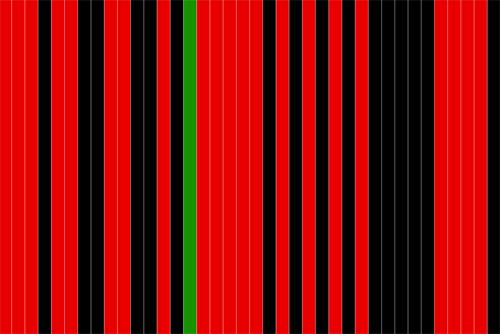
Keith Tyson, History Painting
In a co-promo with The Guardian this morning, Keith Tyson gave away ‘5,000 original works for free’ — the process basically involved slashdotting Tyson’s own cumbersome flash-heavy site until you arrived at a screen where you could type in your own location, which would then generate a roulette-striped print for you, part of an online extension of his series of History Paintings.
If you missed out, here’s mine: download it and print it out (A3 recommended). Does this decrease the value of my ‘edition’ of the work (£100 is the starting price on on eBay)? Does it decrease the value of the edition as a whole? I doubt it, any more than printing the work out and blutacking it above the stationery cupboard to ‘share’ with my colleagues does. Aesthetically, it has some kinship with Maya Roos’ defrag paintings, but for all the fiddling around with randomness and generativity going on in this work, the idea of ‘editions’ is fundamentally pretty antithetical to the internet, a domain of infinite reproducibility, and the ‘released at noon’ gimmick a rather tired stunt.
On the morning that the Guardian came with a sheet of christmas wrapping paper ‘designed’ by Sienna Miller, we should probably allow for some seasonal lowering of standards. But there’s something truly sophomoric about Charlotte Higgins’ assertion that “Tyson’s attempt to colonise the web highlights how little, in fact, mainstream artists have harnessed its possibilities”.
In fact the really puzzling question is why mainstream contemporary art has so little interest in the possibilities and problems created by the internet. At the end of the article Higgins can do no more than assert that today’s art students watch YouTube and know about UbuWeb, which are both mostly vast archives of media objects. They’re each in their own way critical repositories of artistic history, but neither has much to do with any kind of online practice.
The disavowal of the internet might have something to do with the financialisation of the artworld so slobberingly documented by Sarah Thornton which demands a kind of differential pricing (original works for the collectors, editions for the serious fans, and mass market prints for the plebs), to achieve maximum market penetration. The web’s good for selling stuff like this, but work which is infinitely-reproducible, non-object, collectively created, ephemeral or politically aggressive, as online art tends to be, doesn’t really add any value for anyone but the audience.
Charlie Gere has a more in-depth analysis on CRUMB:
Institutions such as the ICA or Tate are absolutely invested in the quasi-religious mystagogy of contemporary art … This is I think the source of their resistance to New Media Art, which for me is like Toto in the Wizard of Oz, pulling back the curtain to reveal that the great Oz, the big Other, is nothing but a funny little man manipulating some levers and shouting into a microphone, or in other words art is nothing but a manipulation of material means and techniques. This is perhaps why NMA does not invoke the kind of emotional reactions that other Art does. That is perhaps both its strength and its weakness. It repudiates the mystagogical claims to transcendence that Art still needs to be believed in. No wonder Eshun and Bourriaud and all the others don’t want to have anything to do with it. It is not in their interests to have the curtain drawn back, which NMA arguably does by engaging in the fundamental technicity of all art through its own practice, which is otherwise disavowed. They’d rather have the big green shouty head.
which only suffers a little from the recursive what-is-art quandary of academic art discourse.
Apparently, Tyson also “hopes to exploit its possibilities more fully, by creating communities and open forums for discussions.” That’ll put him in direct and pointless competition with everyone from ArtReview to Facebook, then. (Remember when David Bowie transformed himself into an ISP? He can’t even keep his own website up to date these days.) Good luck with that, Keith.
If you’re interested in internet-based art, two of my personal recommendations are Harwood’s Uncomfortable Proximity and Tomoko Takahashi’s Word Perhect, both a few years old, but imho still politically and aesthetically valid. For a historical perspective, read Vuk Cosic or Olia Lialina. Visit the HTTP Gallery. Look at runme.org, ljudmila, furtherfield.org, and even Rhizome. But don’t expect to learn much from a Turner Prize winner.





